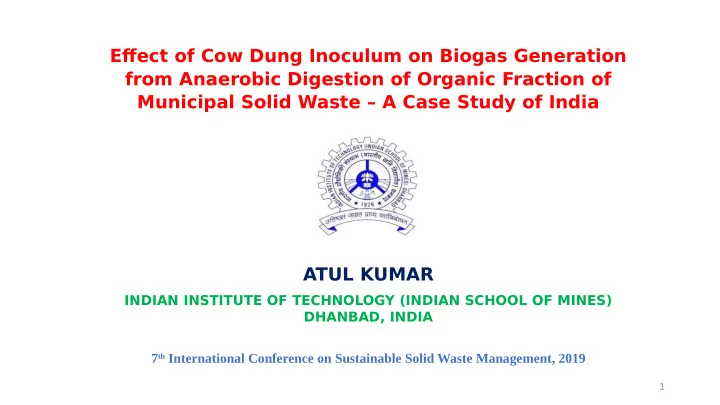

Efgect of Cow Dung Inoculum on Biogas Generation from Anaerobic Digestion of Organic Fraction of Municipal Solid Waste – A Case Study of India ATUL KUMAR INDIAN INSTITUTE OF TECHNOLOGY (INDIAN SCHOOL OF MINES) DHANBAD, INDIA 7 th International Conference on Sustainable Solid Waste Management, 2019 1
What are we going to learn today? • Motivation for this study • Objectives • Materials and methods • Key results • Conclusions 2
Motivation for this study • One-third of total world food production gets wasted every year. • Most of the organic wastes meets with the traditional disposal techniques. • Scarcity of suitable land for landfilling. • Stringent regulations. • Potent renewable energy source. • Reduce the environmental impacts. Fig. 1: Anaerobic digestion process 3
Objectives • T o identify the optimum combination of OFMSW and CM for effjcient anaerobic digestion. 4
Materials and methods • Feedstock materials • Leftover food waste and other degradable wet organic waste. • The co-digestion substrate was cow dung (CM) collected from a farm. • Reactor Set-up • Aspirator glass bottles of capacity 1000 mL with bottom sampling port were used. • The experiments were performed in batch. 5
Fig. 2: Experimental set-up of the anaerobic batch reactor 6
Reactor Set-up (Continue..) • The reactors were filled with four different substrate to inoculum ratio (0.5, 0.63, 0.75 and 1.0) based on VS contents. • The inoculum and substrate were thoroughly mixed in the blender before being added to the reactor. • All the reactors were operated at mesophilic temperature (35 ± 1 °C). • Water displacement method was used for biogas production measurement at a fixed time every day. • The other end of silicone tube was inserted in an inverted 50 ml graduated measuring cylinder filled with water, whereas in duplicate it was 1.5 N NaOH solution. • The reactors were terminated at the end of 30 th day. 7
Analytical methods • The Characteristics of the collected samples were analysed in the laboratory. Parameter OFMSW CM Table 1: Characteristics of feedstock materials Moisture content (%) 81.2 84.4 pH 5.3 7.4 Total Solid (TS) (%) 18.8 15.6 Volatile Solid (VS) (% d.b.) 90 79.3 COD (mg/L) 79800 19600 Carbon, C (% d.b.) 45.12 37.34 Nitrogen, N (% d.b.) 1.58 3.03 C/N ratio 28.56 12.32 8
Table 2: Combinations of feedstock in batch reactors Reactor Mixing ratio of OFMSW (g CM (g VS/L) Organic loading (g VS/L) OFMSW and CM (on VS/L) VS basis) R1 - 0 10 10 R2 0.50 5 10 15 R3 0.63 6.3 10 16.3 R4 0.75 7.5 10 17.5 R5 1.00 10 10 20 9
Key results Variation of pH in the reactors 8,5 • During hydrolysis, the substrates get 8 converted into amino acids and fatty acids 7,5 which lead to accumulation of volatile fatty 7 6,5 acids (VFA) resulting in a decrease in pH of pH 6 the reactor. 5,5 • Till 12-15 days the pH in all the reactors 5 4,5 gradually decreases. 4 0 5 10 15 20 25 30 • Due to CM as a co-substrate, the pH of the Time (days) reactors again increases which creates favourable environment for the R1 R2 R3 R4 R5 methanogenic bacteria. Fig. 3: Variation of pH of the reactors 10
Biogas generation B io g a s g en era tio n (m L ) • The maximum biogas production was found in reactor R2. • The percentage of methane in the 1800 generated biogas was 62%. 1600 1400 1200 1000 800 600 400 200 0 R1 R2 R3 R4 R5 Reactors Fig. 4: Biogas generated in the reactors 11
• The biogas production of 1594 1800 1600 mL at S/I ratio of 0.5, followed 1400 Cumulative biogas (mL) by 1301 mL at 0.63, 1152 mL at 1200 0.75 and 1037 mL at 1.0. 1000 800 • The biogas generation was very 600 less from mono-digestion of CM 400 200 (R1). 0 0 5 10 15 20 25 30 Time (days) R1 R2 R3 R4 R5 Fig. 5: Cumulative biogas generation 12
Conclusions • The biogas yield in the different reactors are not very encouraging. • The maximum biogas yield of 106.27 mL/g VS was observed in reactor R2. • The order of biogas yield in all the reactors are R2>R3>R4>R5>R1. • The reason for lesser biogas production in all the reactors was due to the drop in pH of the reactors at initial stage of the reaction. 13
Acknowledgement: I want to thank Department of Science and Technology, Govt. of India, for providing me funding opportunity for attending this conference. Thank You & Questions? 14
Recommend
More recommend